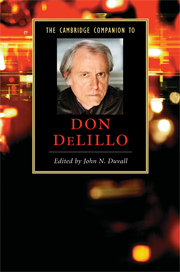Book contents
- Frontmatter
- Introduction: The power of history and the persistence of mystery
- PART I AESTHETIC AND CULTURAL INFLUENCES
- PART II EARLY FICTION
- PART III MAJOR NOVELS
- PART IV THEMES AND ISSUES
- 9 DeLillo and masculinity
- 10 DeLillo's Dedalian artists
- 11 DeLillo and the power of language
- 12 DeLillo and mystery
- Conclusion: Writing amid the ruins: 9/11 and Cosmopolis
- Select bibliography
- Guide to further reading
- Index
- Series List
10 - DeLillo's Dedalian artists
from PART IV - THEMES AND ISSUES
Published online by Cambridge University Press: 28 June 2008
- Frontmatter
- Introduction: The power of history and the persistence of mystery
- PART I AESTHETIC AND CULTURAL INFLUENCES
- PART II EARLY FICTION
- PART III MAJOR NOVELS
- PART IV THEMES AND ISSUES
- 9 DeLillo and masculinity
- 10 DeLillo's Dedalian artists
- 11 DeLillo and the power of language
- 12 DeLillo and mystery
- Conclusion: Writing amid the ruins: 9/11 and Cosmopolis
- Select bibliography
- Guide to further reading
- Index
- Series List
Summary
When Don DeLillo was asked in a 1979 interview – the first he ever gave – why he shunned publicity and rarely spoke about his work, he replied, “Silence, exile, cunning, and so on.” He was quoting James Joyce's A Portrait of the Artist as a Young Man (1916), wherein protagonist Stephen Dedalus famously vows to use those three “arms” to defend his art from the intrusions of nationalism, religion, and domesticity. DeLillo's novels about artists – Great Jones Street (1973), Mao II (1991), and The Body Artist (2001) – sustain a dialogue with these modernist, “Dedalian” aesthetic principles. Each novel depicts the lure of silence and exile, as each artist figure coils inward in order to spring outward, often with a new work that redefines his or her artistic practice.
This pattern indeed forms a link in an intertextual chain that leads back to the Greek myth from which Stephen takes his name. Daedalus was, of course, the artificer who built a nearly inescapable labyrinth for King Minos of Crete, where he kept the half-bull, half-human Minotaur and fed him human sacrifices. Taking one victim's place, the Athenian prince Theseus killed the Minotaur and escaped afterward using a thread given to him by Minos's daughter, Ariadne. Later, Daedalus himself was imprisoned in the labyrinth but, by fashioning wings from feathers and wax, escaped with his son, Icarus. Failing to heed his father's warnings, Icarus flew too close to the sun; his wax wings melted and he fell into the sea. Daedalus subsequently put aside his wings, but after enviously murdering his clever nephew Perdix, he was transformed by Athena into a bird.
- Type
- Chapter
- Information
- The Cambridge Companion to Don DeLillo , pp. 137 - 150Publisher: Cambridge University PressPrint publication year: 2008
- 4
- Cited by

